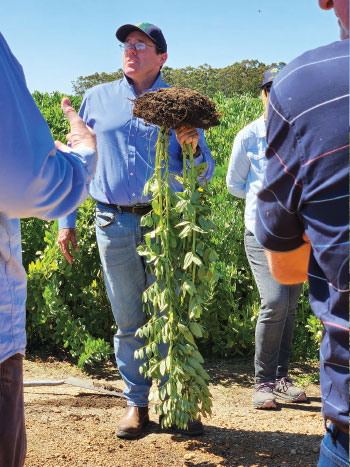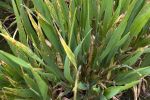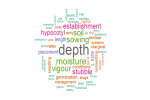Key points
- Adoption of grain legumes by growers in the west has been stymied by poor commodity prices, yield variability and limited market access
- Innovations in genetics, acid-tolerant rhizobia and agronomic practices are making legumes viable on acidic and sandy soils
- Improved export pathways and marketing strategies, particularly for crops such as faba beans, aim to build grower confidence
- Grain legumes contribute nitrogen fixation and rotational benefits, with multi-year analyses underway to quantify their economic value
- The Legume Leaders campaign promotes knowledge sharing among growers, supported by research trials and expert insights
A combination of innovative research and strategic collaboration is boosting the profitability of grain legumes in Western Australia’s farming systems
Both the challenges and opportunities that legume crop production presents have been highlighted in new research into their incorporation in Western Australian crop rotations.
While legumes promise nitrogen fixation, rotational benefits and potential profitability, their adoption in the west remains limited due to decades of mixed results. However, recent advances in genetic adaptation, rhizobia and agronomic practices – as well as access to premium export markets – are offering new pathways to profitable legume production.
Grower Group Alliance (GGA) head of projects Dr Daniel Kidd, who leads the GRDC investment ‘Closing the economic yield gap of grain legumes’, says the release of acid-tolerant rhizobia strains in 2024 was among the most promising developments.
 Grower Group Alliance head of projects Dr Daniel Kidd leads the ‘Closing the economic yield gap of grain legumes’ project. Photo: supplied
Grower Group Alliance head of projects Dr Daniel Kidd leads the ‘Closing the economic yield gap of grain legumes’ project. Photo: supplied
The new products – Group E for inoculating field peas, lentils and vetch, and Group F for faba beans and broad beans – have been shown to increase nodulation and nitrogen fixation in acidic soils.
“The new commercial strains allow plants to grow in soils down to about pH 5.5,” he says.
“This is a huge breakthrough, as many WA growers aim for this pH level in their soil liming programs. It potentially opens up large areas of WA to better legume production.”
While soil acidity has been a major limiting factor, genetic improvements in legume varieties are gradually increasing yields over time. However, yield variability remains a significant concern for growers.
“We’re noticing some growers can grow a four tonnes per hectare lupin crop, and yet the state average is still under 2t/ha,” Dr Kidd says.
A peer-learning approach
To tackle the knowledge gap in legume production, the project launched a Legume Leaders campaign connecting nine successful legume growers with those looking to incorporate these crops into their rotations.
 West Midlands Group executive officer Nathan Craig studies root development on chickpeas during a field day at Dandaragan in July 2023. Photo: Daniel Kidd
West Midlands Group executive officer Nathan Craig studies root development on chickpeas during a field day at Dandaragan in July 2023. Photo: Daniel Kidd
The campaign includes a series of seven podcasts produced throughout 2024 featuring interviews with the advocates, who collectively represent more than 200 years of growing experience.
“These guys are a good resource and have made themselves available,” Dr Kidd says.
“They have made all the mistakes previously and tweaked their systems. It’s worth having a chat with more experienced operators so you don’t make those early mistakes, because if you fail with one crop you might not revisit it again.
“We’re trying to address that education because legumes are traditionally more difficult to grow than cereals or even canola.”
The 13 grower groups in the GGA are running demonstration trials and encouraging their members to think outside the box and consider high-value legumes, including those not generally grown in their area, to improve crop diversity.
Vetch, for example, is gaining interest not just for grazing but also as a brown manure crop alternative to bare fallow.
 WA Department of Primary Industries and Regional Development senior research scientist Mark Seymour (centre) checks the roots of poorly nodulated vetch during a field day near Lake Toolbrunup in September 2023. Photo: Daniel Kidd
WA Department of Primary Industries and Regional Development senior research scientist Mark Seymour (centre) checks the roots of poorly nodulated vetch during a field day near Lake Toolbrunup in September 2023. Photo: Daniel Kidd
“If you can grow vetch, which is traditionally grown in a heavy red loam soil, then that’s also conducive to growing lentils, which currently has a much higher market value,” Dr Kidd says.
“And lentils traditionally need pH of 6.5 or more, but now, with the new rhizobia, you can grow them in more acidic soils.”
Economic considerations
While the agronomic benefits of legumes are well established, the economic case has been harder to make in recent years.
Canola, with its high prices and improved varieties, has largely displaced lupins as the break crop of choice in many WA rotations.
“If you graph the production area of lupins, it crosses over perfectly with the uptick in canola,” Dr Kidd says.
Department of Primary Industries and Regional Development senior research scientist Mark Seymour highlighted the historic importance of lupins in WA during the first Legume Leaders podcast episode last May.
“At one point, we had a million hectares of narrow-leaf lupins,” Mr Seymour says.
 WA Department of Primary Industries and Regional Development research scientist Glenn McDonald discusses faba bean agronomy during a field day at Perillup in October 2024. Photo: Daniel Kidd
WA Department of Primary Industries and Regional Development research scientist Glenn McDonald discusses faba bean agronomy during a field day at Perillup in October 2024. Photo: Daniel Kidd
“That was before the rise of continuous cropping, and certainly before the rise of canola as a robust competitor in that space. We’re now hovering around the 300,000ha level.”
Quantifying the benefits
One of the project’s key objectives is to better quantify the economic benefits of including legumes in a rotation.
This includes not only the immediate gross margin of the legume crop, but also the nitrogen it makes available to subsequent crops and the value of disease and weed breaks.
“For every tonne of dry matter that you grow, it contributes roughly 25 to 30 units of nitrogen,” Dr Kidd says.
“If you grew a 5t/ha crop, you could have up to 120 to 150kg of nitrogen per hectare, potentially available in the following one, two or even three years.”
Looking forward
As the project progresses, it will continue to define agronomic, financial and market information to help growers and advisers make informed decisions. By building confidence in legume production and identifying research gaps, the project aims to pave the way for a more diverse and resilient cropping system in WA. Dr Kidd says including legumes in the rotation is not a new concept, but the challenge is to demonstrate they can also be profitable.
More information: Daniel Kidd, daniel.kidd@gga.org.au; Scott Merson, smerson@sunrisecommodities.com.au
See also: GroundCover™ story – Shift in planting time offers new market opportunity.

























































